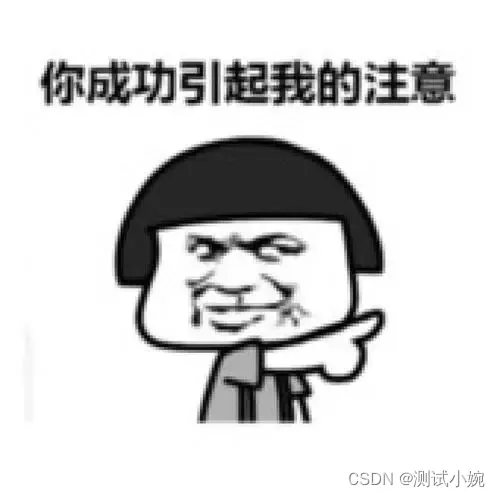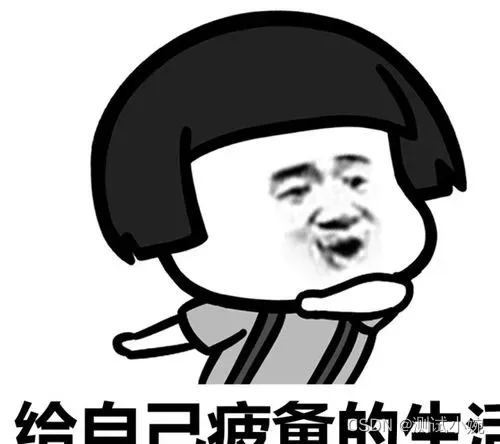当前位置:网站首页>Learning record: Tim - capacitive key detection
Learning record: Tim - capacitive key detection
2022-07-06 15:24:00 【Bitter tea seeds】
Catalog
One 、 Principle of capacitive key
1.1、 Touch the capacitive button without fingers
1.2、 There are fingers touching the capacitive button
1.3、Vc Relationship between voltage and charging time
2.2、 Check the specific process of pressing the capacitive button
Preface
( Reference resources 《 Wildfire reference manual 》)
Capture function through input , To make a capacitive touch button . use TIM5 The passage of 2(PA1) For input capture , And realize a simple capacitive touch button , Through this key control DS1 On and off .
Capacitive buttons do not require any external mechanical components , Easy to use , The cost is low , It is easy to make a keyboard sealed with the surrounding environment , In order to play the role of moisture prevention . The outstanding advantages of capacitive keys make more and more electronic products use it to replace the traditional mechanical keys .
One 、 Principle of capacitive key
Capacitor ( It is called capacitance for short ) It's a device that can hold charge , A layer of insulator between two metal blocks can form the simplest capacitor . There are two pieces of metal , There is an insulating medium between , This forms a capacitor . Such a capacitor is very easy to realize on the circuit board , Generally, the copper pieces around the design are connected with the signal of the circuit board , Such a structure is the model of capacitive buttons . When the shape of the circuit board is fixed , The capacity of the capacitor is also relatively stable .

When making circuit boards, an insulating layer will be covered on the surface , For corrosion protection and insulation , So the actual circuit board design situation As shown in the figure, there is no finger touch . The top layer of the circuit board is insulating material , The next layer is conductive copper foil , According to the circuit routing Design determines the shape of copper foil , The next floor is usually FR-4 board . There is insulating material between the metal sensor and the ground signal , The whole can be equivalent to a capacitor Cx. Usually when designing , The metal sensor is designed to be convenient for fingers to touch .
1.1、 Touch the capacitive button without fingers
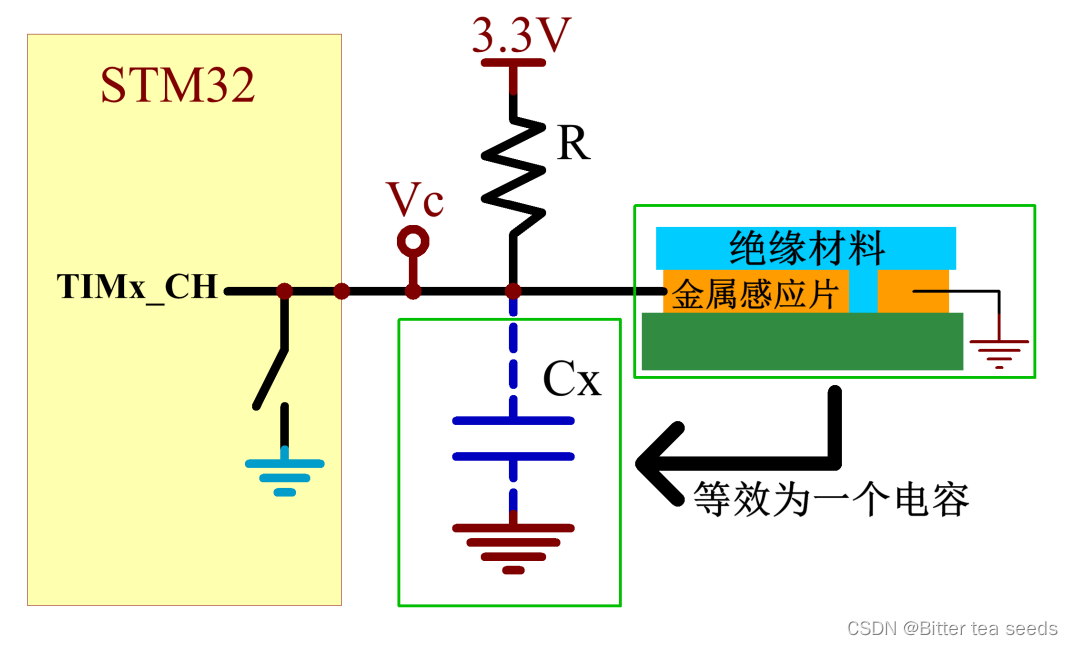
When the circuit board is not powered on , It can be considered that capacitance  There is no charge , On power up , Under the action of resistance , capacitance
There is no charge , On power up , Under the action of resistance , capacitance  There will be a charging process , Until the capacitor is full , namely
There will be a charging process , Until the capacitor is full , namely  The voltage value is 3.3V, The length of this charging process is affected by resistance R Resistance and capacitance
The voltage value is 3.3V, The length of this charging process is affected by resistance R Resistance and capacitance  Direct influence of capacitance . But in choosing the right resistance R After welding and fixing to the circuit board , This charge Time will basically not change , Because at this time, the resistance R It's fixed , capacitance
Direct influence of capacitance . But in choosing the right resistance R After welding and fixing to the circuit board , This charge Time will basically not change , Because at this time, the resistance R It's fixed , capacitance  It is basically unchanged without obvious external interference .
It is basically unchanged without obvious external interference .
1.2、 There are fingers touching the capacitive button
When we touch with our fingers , In addition to forming an equivalent capacitance with the ground signal  Outside , It will also form a
Outside , It will also form a  Equivalent capacitance .
Equivalent capacitance .
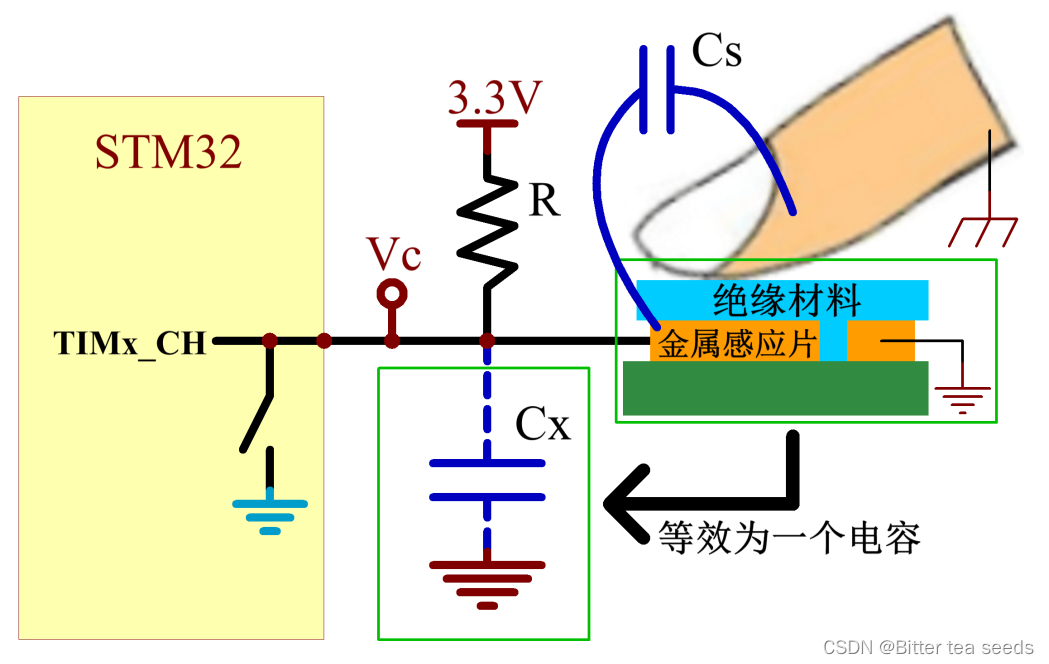
At this time, the whole capacitive button can hold more charge than when there is no finger touch , It can be seen as  and
and  The effect of stacking . At the same resistance R Under the circumstances , Because the capacitance value increases , This leads to a longer charging time . That is, the longer the charging time makes us distinguish whether there is finger touch , That is, whether the capacitive button is pressed .
The effect of stacking . At the same resistance R Under the circumstances , Because the capacitance value increases , This leads to a longer charging time . That is, the longer the charging time makes us distinguish whether there is finger touch , That is, whether the capacitive button is pressed .
The main task is to measure the charging time . The charging process can be seen as a signal from low level to high level cheng , Now is the time to ask for this change process . We can use the timer input capture function to calculate the charging time , namely Set up TIMx_CH Enter the capture mode channel for the timer . In this way, the charging time without touch is measured first as the reference , Then periodically measure the charging time and compare it with the charging time without touch , If it exceeds a certain threshold, it is considered that there is a finger touch .
1.3、Vc Relationship between voltage and charging time
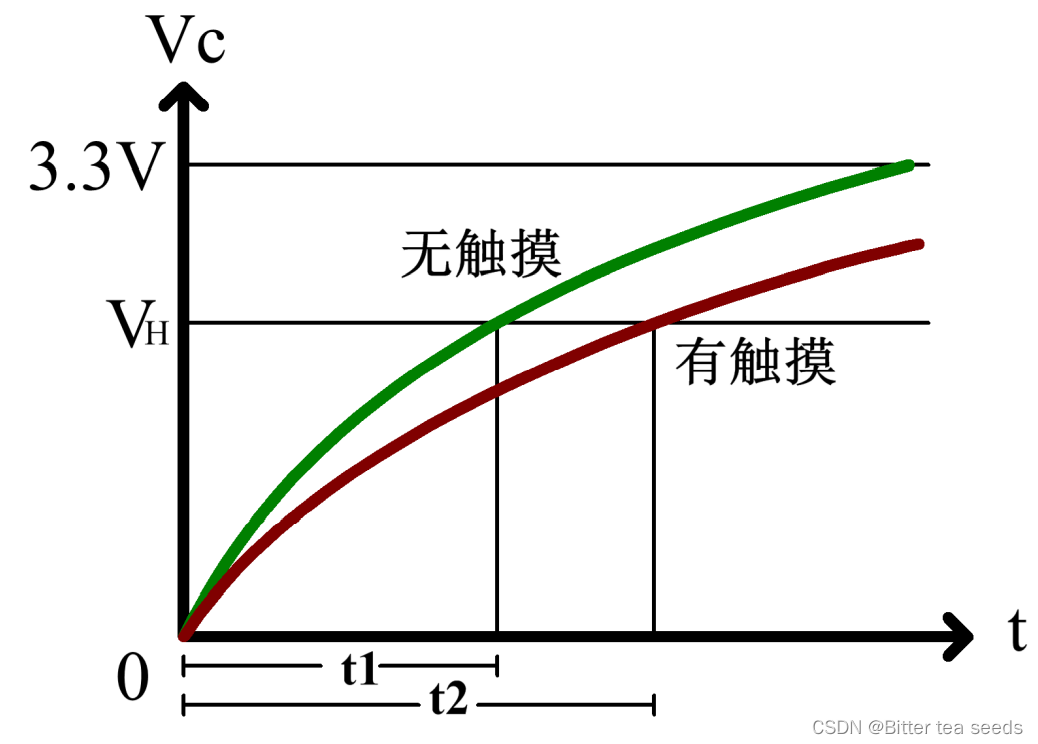
To measure the charging time , You need to set the timer input capture function to trigger the rising edge , In the figure VH Is the voltage value of the triggered rising edge , It's also STM32 It is considered as the lowest voltage value of high level , about 1.8V.
t1 and t2 It can be captured by timer / Compare registers to get .
Before measuring the charging time , To make this charging process . There will be a charging process when the circuit board is powered on , Now it is required to cycle through the keys while the program is running , Therefore, the generation of charging process must be controlled . Can be controlled TIMx_CH Pin as ordinary GPIO Use , Make it output low level for a short period of time , For capacitance Cx discharge , namely Vc by 0V. When reconfigured TIMx_CH Is the capacitance at the time of input capture Cx In resistance R The charging process can be produced under the action of .
Two 、 Programming
2.1、 Design thinking
(1) Write timer input capture correlation function (2) Measure the no-load charging time of the capacitor button T1(3) Measure the charging time when the capacitive button is touched by hand T2(4) Just compare T2 And T1 Time to detect whether the key is touched by fingers
2.2、 Check the specific process of pressing the capacitive button
- TPAD The pin is set to push-pull output , Output 0, Discharge the capacitor to 0.
- TPAD The pin is set to float input (IO The state after reset ), The capacitor starts charging .
- At the same time open TPAD The input capture of the pin starts to capture .
- Wait for the charge to complete ( Charging to the end Vx, Rising edge detected ).
- Calculate the charging time .
2.3、 Project code
tpad.c The code is as follows :
#include "tpad.h"
#include "delay.h"
#include "usart.h"
#define TPAD_ARR_MAX_VAL 0XFFFF // maximal ARR value
vu16 tpad_default_val=0;// When it's empty ( No hands pressed ), The time the counter takes
// Initialize touch button
// Get the value of touch button when empty .
// Return value :0, Successful initialization ;1, initialization failed
u8 TPAD_Init(u8 psc)
{
u16 buf[10];
u16 temp;
u8 j,i;
TIM5_CH2_Cap_Init(TPAD_ARR_MAX_VAL,psc-1);// With 1Mhz Frequency count of
for(i=0;i<10;i++)// Read continuously 10 Time
{
buf[i]=TPAD_Get_Val();
delay_ms(10);
}
for(i=0;i<9;i++)// Sort
{
for(j=i+1;j<10;j++)
{
if(buf[i]>buf[j])// Ascending order
{
temp=buf[i];
buf[i]=buf[j];
buf[j]=temp;
}
}
}
temp=0;
for(i=2;i<8;i++)temp+=buf[i];// Take the middle one 6 Average the data
tpad_default_val=temp/6;
printf("tpad_default_val:%d\r\n",tpad_default_val);
if(tpad_default_val>TPAD_ARR_MAX_VAL/2)return 1;// Initialization encountered more than TPAD_ARR_MAX_VAL/2 The numerical , Is not normal !
return 0;
}
// Reset once
void TPAD_Reset(void)
{
GPIO_InitTypeDef GPIO_InitStructure;
RCC_APB2PeriphClockCmd(RCC_APB2Periph_GPIOA, ENABLE); // Can make PA Port clock
// Set up GPIOA.1 To push and pull
GPIO_InitStructure.GPIO_Pin = GPIO_Pin_1; //PA1 port configuration
GPIO_InitStructure.GPIO_Mode = GPIO_Mode_Out_PP; // Push pull output
GPIO_InitStructure.GPIO_Speed = GPIO_Speed_50MHz;
GPIO_Init(GPIOA, &GPIO_InitStructure);
GPIO_ResetBits(GPIOA,GPIO_Pin_1); //PA.1 Output 0, discharge
delay_ms(5);
TIM_SetCounter(TIM5,0); // return 0
TIM_ClearITPendingBit(TIM5, TIM_IT_CC2|TIM_IT_Update); // Clear interrupt flag
// Set up GPIOA.1 Enter... For the float
GPIO_InitStructure.GPIO_Mode=GPIO_Mode_IN_FLOATING; // Floating input
GPIO_Init(GPIOA, &GPIO_InitStructure);
}
// Get the timer capture value
// If the timeout , Then it directly returns the count value of the timer .
u16 TPAD_Get_Val(void)
{
TPAD_Reset();
while(TIM_GetFlagStatus(TIM5, TIM_IT_CC2) == RESET)// Wait for the rising edge to capture
{
if(TIM_GetCounter(TIM5)>TPAD_ARR_MAX_VAL-500)return TIM_GetCounter(TIM5);// It's overtime , Go straight back to CNT Value
};
return TIM_GetCapture2(TIM5);
}
// Read n Time , Taking the maximum
//n: The number of consecutive acquisitions
// Return value :n The maximum reading value read in the second reading
u16 TPAD_Get_MaxVal(u8 n)
{
u16 temp=0;
u16 res=0;
while(n--)
{
temp=TPAD_Get_Val();// Get a value
if(temp>res)res=temp;
};
return res;
}
// Scan touch button
//mode:0, Continuous triggering is not supported ( You have to release it once to press it again );1, Support continuous trigger ( You can press it all the time )
// Return value :0, Didn't press ;1, There is a press ;
#define TPAD_GATE_VAL 100 // Threshold of touch , That is, it must be greater than tpad_default_val+TPAD_GATE_VAL, It's effective touch .
u8 TPAD_Scan(u8 mode)
{
static u8 keyen=0; //0, You can start testing ;>0, We can't start testing yet
u8 res=0;
u8 sample=3; // The default number of samples is 3 Time
u16 rval;
if(mode)
{
sample=6; // When you support multi click , Set the sampling number to 6 Time
keyen=0; // Support to click
}
rval=TPAD_Get_MaxVal(sample);
if(rval>(tpad_default_val+TPAD_GATE_VAL))// Greater than tpad_default_val+TPAD_GATE_VAL, It works
{
if(keyen==0)res=1; //keyen==0, It works
//printf("r:%d\r\n",rval);
keyen=3; // At least again 3 The key will not be valid until after
}
if(keyen)keyen--;
return res;
}
// Timer 2 passageway 2 Input capture configuration
void TIM5_CH2_Cap_Init(u16 arr,u16 psc)
{
GPIO_InitTypeDef GPIO_InitStructure;
TIM_TimeBaseInitTypeDef TIM_TimeBaseStructure;
TIM_ICInitTypeDef TIM5_ICInitStructure;
RCC_APB1PeriphClockCmd(RCC_APB1Periph_TIM5, ENABLE); // Can make TIM5 The clock
RCC_APB2PeriphClockCmd(RCC_APB2Periph_GPIOA, ENABLE); // Can make PA Port clock
// Set up GPIOA.1 Enter... For the float
GPIO_InitStructure.GPIO_Pin = GPIO_Pin_1; //PA1 port configuration
GPIO_InitStructure.GPIO_Speed = GPIO_Speed_50MHz; // Speed 50MHz
GPIO_InitStructure.GPIO_Mode=GPIO_Mode_IN_FLOATING; // Floating input
GPIO_Init(GPIOA, &GPIO_InitStructure); // Set to float input
// initialization TIM5
TIM_TimeBaseStructure.TIM_Period = arr; // Set the counter to automatically reload
TIM_TimeBaseStructure.TIM_Prescaler =psc; // Preassigned frequency counter
TIM_TimeBaseStructure.TIM_ClockDivision = TIM_CKD_DIV1; // Set the clock split :TDTS = Tck_tim
TIM_TimeBaseStructure.TIM_CounterMode = TIM_CounterMode_Up; //TIM Upcount mode
TIM_TimeBaseInit(TIM5, &TIM_TimeBaseStructure); // according to TIM_TimeBaseInitStruct The parameter specified in TIMx Unit of time base
// Initialize channel 2
TIM5_ICInitStructure.TIM_Channel = TIM_Channel_2; //CC1S=01 Select input IC2 Mapping to TI5 On
TIM5_ICInitStructure.TIM_ICPolarity = TIM_ICPolarity_Rising; // Rising edge capture
TIM5_ICInitStructure.TIM_ICSelection = TIM_ICSelection_DirectTI;
TIM5_ICInitStructure.TIM_ICPrescaler = TIM_ICPSC_DIV1; // Configure the input divider , Regardless of the frequency
TIM5_ICInitStructure.TIM_ICFilter = 0x03;//IC2F=0011 Configure input filter 8 A timer clock cycle filter
TIM_ICInit(TIM5, &TIM5_ICInitStructure);// initialization I5 IC2
TIM_Cmd(TIM5,ENABLE ); // Enable timer 5
}
tpad.h The code is as follows :
#ifndef __TPAD_H
#define __TPAD_H
#include "sys.h"
extern vu16 tpad_default_val;
void TPAD_Reset(void);
u16 TPAD_Get_Val(void);
u16 TPAD_Get_MaxVal(u8 n);
u8 TPAD_Init(u8 psc);
u8 TPAD_Scan(u8 mode);
void TIM5_CH2_Cap_Init(u16 arr,u16 psc);
#endif
main.c The code is as follows :
#include "led.h"
#include "delay.h"
#include "key.h"
#include "sys.h"
#include "usart.h"
#include "tpad.h"
int main(void)
{
u8 t=0;
delay_init(); // Delay function initialization
NVIC_PriorityGroupConfig(NVIC_PriorityGroup_2);// Set up NVIC Interrupt grouping 2:2 Bit preemption priority ,2 Bit response priority
uart_init(115200); // The serial port is initialized to 115200
LED_Init(); //LED Port initialization
TPAD_Init(6); // Initialize touch button
while(1)
{
if(TPAD_Scan(0)) // Successfully captured a rising edge ( This function takes at least 15ms)
{
LED1=!LED1; //LED1 Take the opposite
}
t++;
if(t==15)
{
t=0;
LED0=!LED0; //LED0 Take the opposite , Prompt program is running
}
delay_ms(10);
}
}
边栏推荐
- csapp shell lab
- What if software testing is too busy to study?
- What is "test paper test" in software testing requirements analysis
- Global and Chinese markets of cobalt 2022-2028: Research Report on technology, participants, trends, market size and share
- Unpleasant error typeerror: cannot perform 'ROR_‘ with a dtyped [float64] array and scalar of type [bool]
- 51 lines of code, self-made TX to MySQL software!
- LeetCode#53. Maximum subarray sum
- CSAPP Shell Lab 实验报告
- Contest3145 - the 37th game of 2021 freshman individual training match_ A: Prizes
- Eigen User Guide (Introduction)
猜你喜欢

Sleep quality today 81 points
How to do agile testing in automated testing?
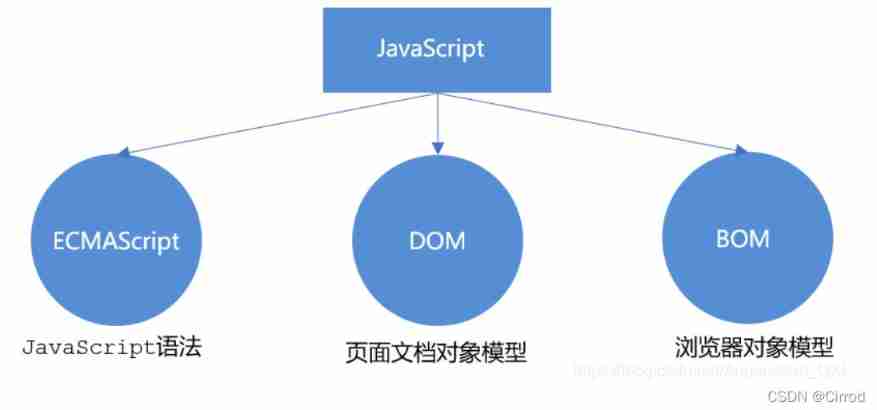
JS --- all basic knowledge of JS (I)
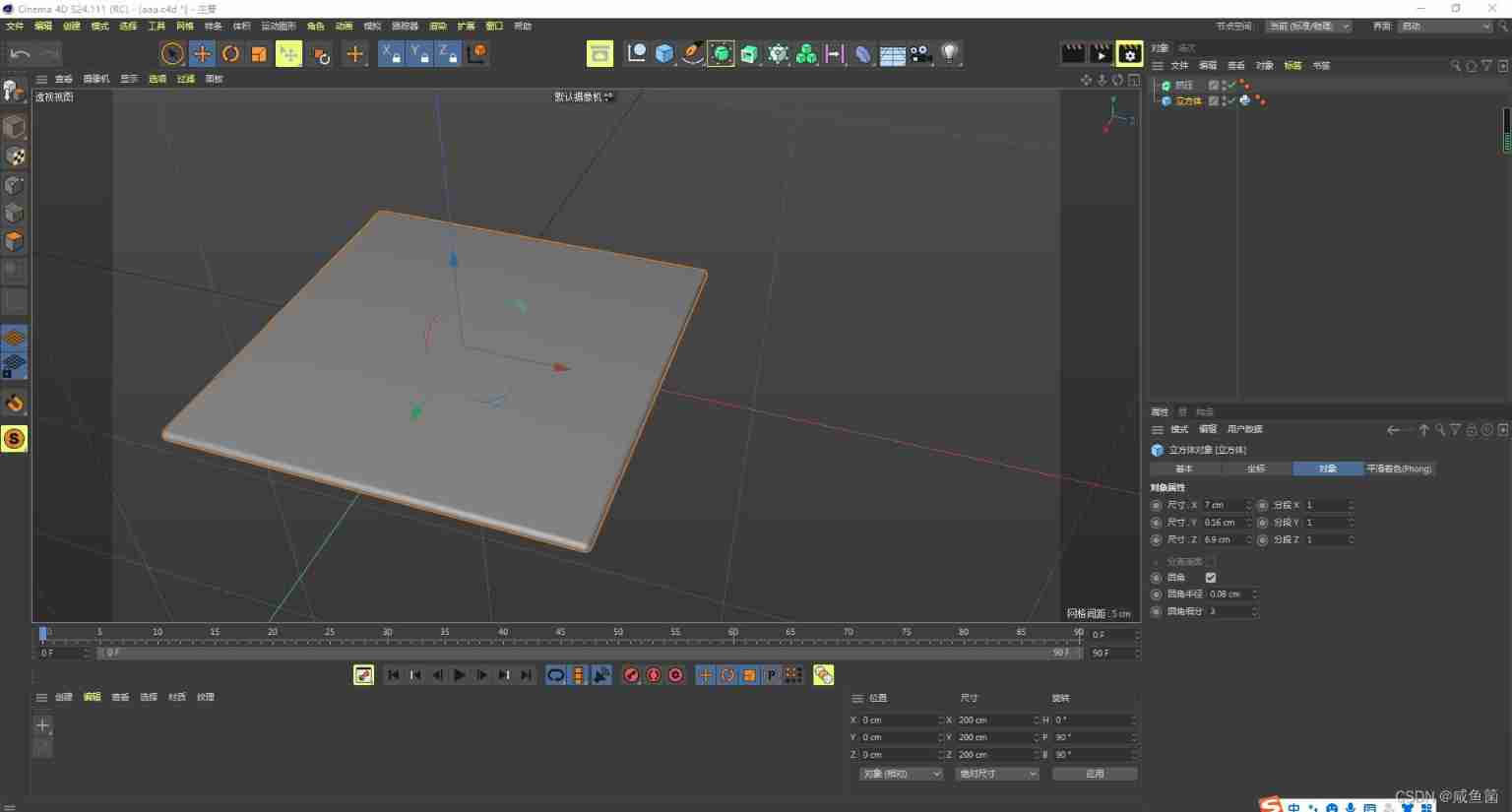
C4D quick start tutorial - Introduction to software interface

The minimum number of operations to convert strings in leetcode simple problem
What to do when programmers don't modify bugs? I teach you
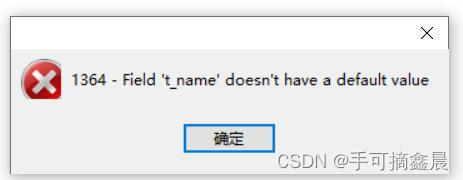
Mysql database (I)

Intensive learning notes: Sutton book Chapter III exercise explanation (ex17~ex29)
转行软件测试必需要知道的知识
软件测试面试回答技巧
随机推荐
Stc-b learning board buzzer plays music 2.0
UCORE lab8 file system experiment report
Investment operation steps
MySQL数据库(三)高级数据查询语句
MySQL数据库(一)
CSAPP家庭作业答案7 8 9章
FSM和i2c实验报告
Dlib detects blink times based on video stream
LeetCode#237. Delete nodes in the linked list
Mysql database (I)
ucore lab 2
Crawler series of learning while tapping (3): URL de duplication strategy and Implementation
csapp shell lab
What if software testing is too busy to study?
Programmers, how to avoid invalid meetings?
Servlet
Jupyter installation and use tutorial
China's county life record: go upstairs to the Internet, go downstairs' code the Great Wall '
CSAPP shell lab experiment report
Unpleasant error typeerror: cannot perform 'ROR_‘ with a dtyped [float64] array and scalar of type [bool]

